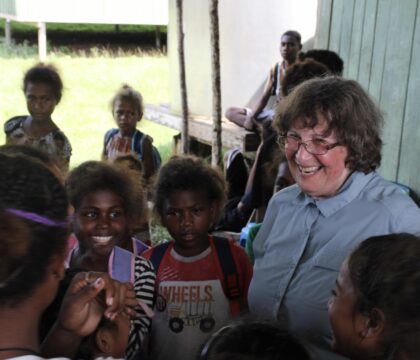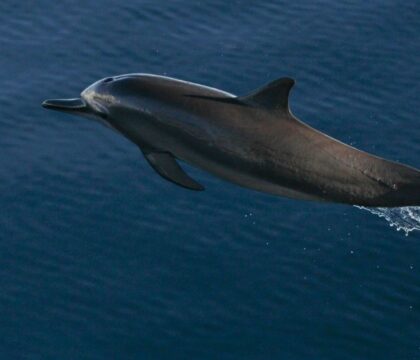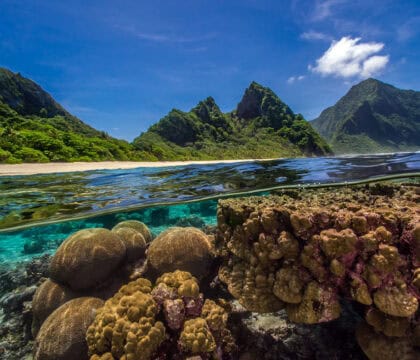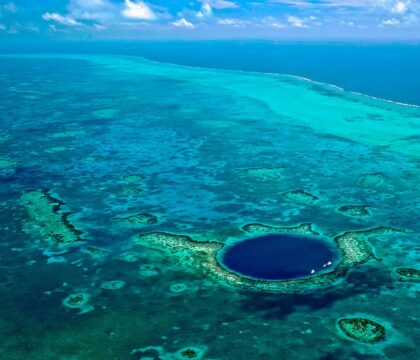April 11, 2025 • Travel Ideas
Acres of seagrass span out from the mangrove-clad islands of Belize’s Turneffe Atoll, a coral-formed atoll in the heart of the Mesoamerican Reef—the second largest barrier reef in the world. Just off of one such island, snorkelers drift above a prairie-like bed of seagrass searching for seahorses and other shy critters, when the boat captain lets out an excited shout. He points to a line of silt spread across the surface of the otherwise clear water.
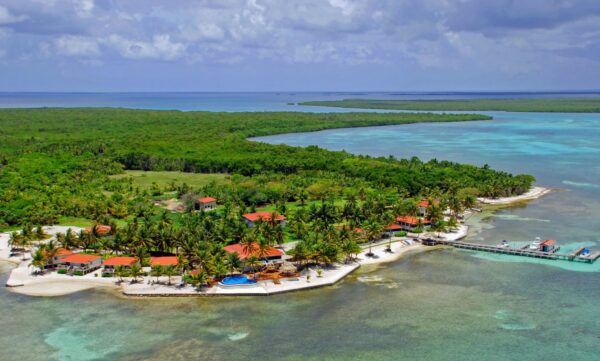
Turneffe Atoll offers a perfect hub for travelers looking to explore the surrounding mangroves, seagrass beds, and coral reef systems of the Belize Barrier Reef – the second largest reef system in the world.
This is a sign that Antillean manatees, rare marine mammals that feed on seagrass, had recently been in the area, says Rosie Jeffrey, Oceanic Society’s manager of strategic partnerships and a naturalist who recently led an Oceanic Society expedition to Belize. Not all travelers are lucky enough to see manatees, so the group returned to the boat to seek them out.
“You track them by following the trail of silt.” Rosie explains that manatees kick up silt from the ocean floor as they feed on seagrass. The trail leads them through a channel of thick mangroves – here the manatees rest, feed, and rear their young away from the open ocean.
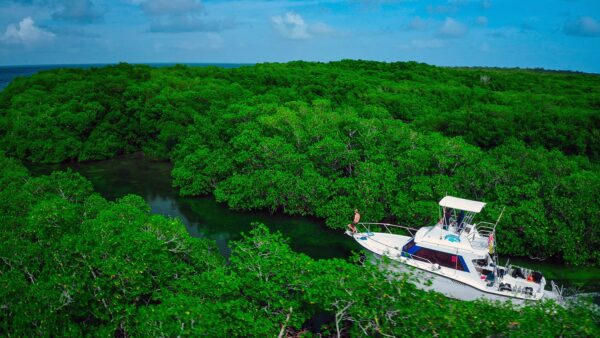
Mangroves cover much of the 200+ islands that surround Turneffe Atoll.
They slow the boat to just a few miles per hour and carefully follow the trail, drifting through the mangroves. The squawking of tropical birds fills the air while the travelers watch the surface looking for the splash of a tail or the surfacing head of a manatee. Meanwhile, the crew is careful not to disturb these sensitive creatures. If separated from their mothers, manatee calves can become lost, explains Rosie.
In a quiet cove, someone spots a grey mass deep below the surface – the thick body of a manatee. Then two adult manatees swim to the surface and dart to a nearby boat that had also tracked them there. The travelers watch in wonder as these animals, whose closest relative is the elephant, splash playfully around the nearby boat, before departing deeper into the mangrove forest.
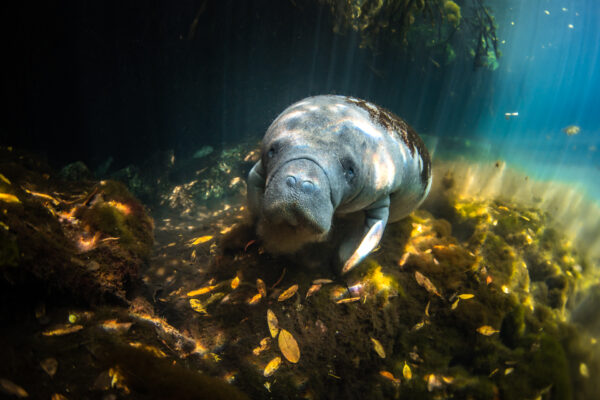
Scientists estimate that only 2,500 Antillean manatees remain. Turneffe Atoll offers one of the best opportunities to see these creatures due to the health of the seagrass beds and mangroves. © Valentina Cucchiara / Ocean Image Bank
Antillean manatees were once abundant in the Caribbean Sea, but coastal development has destroyed many of the seagrass beds that manatees depend on. Yet in Belize’s Turneffe Atoll, this endangered subspecies can still be readily found. Turneffe’s proximity to the open ocean and its combination of thick mangrove forests, sprawling beds of seagrass, and coral reefs interweave to create ideal conditions not only for manatees but also for a staggering array of marine wildlife ranging from dolphins, sharks, and sea turtles, to seahorses and saltwater crocodiles.
The Interweaving Environments of Turneffe Atoll
Belize may be just one or two quick flights away from most major U.S. cities, but Turneffe Atoll, which lies 30 miles off the coast of Belize City, feels as much like a remote island in the South Pacific as an atoll in the heart of the Caribbean Sea.
This impression is partly due to it being one of the very few coral-formed islands in the Atlantic (a phenomenon much more common in the South Pacific), but also due to the lack of tourism development. Despite its location at the heart of the Belize Barrier Reef and a short distance from iconic locations like the Great Blue Hole and Half Moon Caye, Turneffe Atoll hosts just a few lodgings, including Turneffe Flats, where Oceanic Society bases expeditions.
“The thing that’s nice about Turneffe Atoll is that it’s away from all the other distractions,” says Wayne Sentman, Oceanic Society’s director of conservation travel, “That really allows you to have a kind of deeper connection to nature.”
Connecting with nature is best done when “slowing down,” emphasizes Wayne. Many eager travelers want to hurry to the next coral reef for the opportunity to see sharks, sea turtles, or other large species. But spending time in meadows of seagrass and among mangrove forests exposes travelers to a wide variety of wildlife that hide among the flowing foliage and shadowy roots, like eels, crabs, seahorses, and juvenile fish finding refuge from the open ocean.
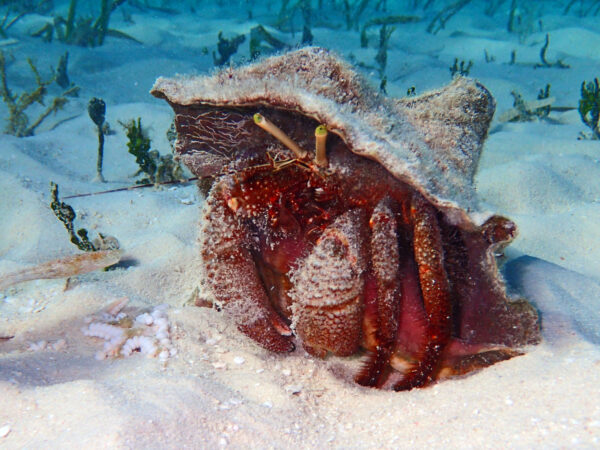
Hermit crabs are just one of the many kinds of crustaceans that can be seen among the meadows of seagrass. © Wayne Sentman
Travelers are often shocked at how many animals can be seen in these less famous environments, especially at the points where they intersect. “The edges where seagrass meets coral, where seagrass meets mangrove, where mangrove meets coral – those produce the diversity,” explains Wayne. The interweaving environments are also crucial to each ecosystem’s health. Seagrass and mangroves cool and regulate the water, which supports the growth of coral reefs. The coral in turn protects the mangroves and seagrass from rough waters coming in from the deeper ocean.
“Travelers come away with a more connected view of what it takes to make a healthy coral reef system,” says Wayne, “That’s something that’s really easy to show people in Turneffe, because you have all the pieces.”
While development threatens much of the Caribbean’s wild, Wayne, who previously managed Oceanic Society’s field research station in Belize (now closed), is confident that Turneffe Atoll can remain what he calls an “oasis in the open ocean.” The surrounding ecosystem of Turneffe Atoll is designated as a Marine Protected Area (thanks in part to the work of Oceanic Society), which provides strong legal protections for wildlife and regulates activities like sand mining, dredging, and commercial fishing. Wayne also highlights that there is a growing contingent of young, Belizean conservationists dedicated to protecting their natural environment.
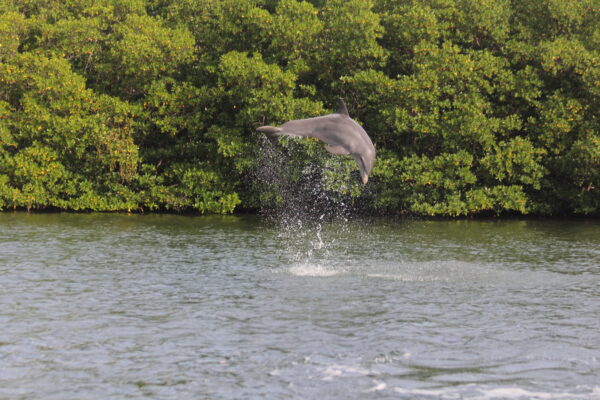
Bottlenose dolphins are just one of the many animals that can be seen in the coastal waters of Turneffe Atoll. © Nataly Castelblanco
Sustainable ecotourism can play a key role in conservation by spreading awareness and cultivating grassroots activism – a core ethos in Oceanic Society’s sustainable travel model. Oceanic Society travelers not only directly sponsor the removal of 200 lbs. of plastic with each booking made, but also support local conservationist groups like the Turneffe Atoll Trust, and the TASA Marine Reserve Station, where their research on species like sea turtles, sharks, and manatees is used to advocate for their protection. Travelers looking for hands-on time supporting conservation in Belize can also join Oceanic Society for a volunteer trip, where they will help collect data on sea turtles, dolphins, and manatees.
“We try to connect our folks to what’s currently being done at Turneffe,” says Wayne, “There’s a younger generation in Belize that has grown up with this conservation ethic, lobbying to keep the natural world protected.”


